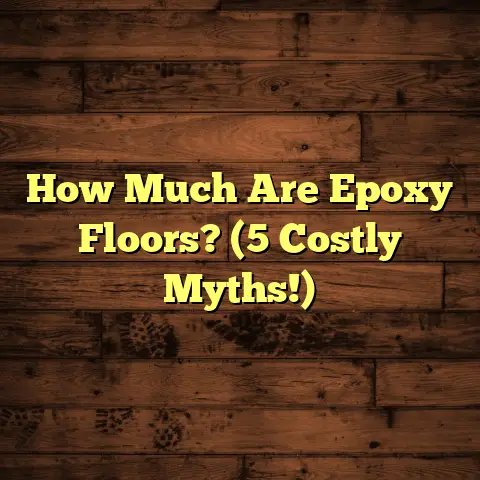Ideal Hardwood Moisture Levels? (5 Must-Knows!)
Hardwood floors are a fantastic choice for homes with pets – they’re stylish, relatively easy to clean, and can add real value to your property.
But here’s the kicker: maintaining them, especially keeping moisture in check, is absolutely crucial for their longevity.
Think of it this way: your hardwood floor is like a living, breathing thing.
It reacts to its environment, expanding and contracting with changes in humidity and temperature.
Throw pets into the mix – with their occasional accidents, grooming routines, and general zoomies – and you’ve got a recipe for potential disaster if you’re not careful.
In this article, I’m going to share my top 5 must-knows for keeping your hardwood floors in tip-top shape, even with your furry friends running around.
We’ll dive into everything from understanding moisture levels to choosing the right type of wood.
Let’s get started!
Section 1: Understanding Hardwood Moisture Levels
Okay, so let’s talk about moisture.
When we talk about moisture levels in hardwood flooring, we’re talking about Moisture Content Percentage (MC%).
This is the amount of water present in the wood, expressed as a percentage of the wood’s dry weight.
Why is this important?
Well, wood is hygroscopic, which basically means it naturally absorbs and releases moisture from the surrounding air.
The ideal moisture range for hardwood floors is typically between 6% to 8%.
Now, this can vary slightly depending on your location and the specific type of wood, but that’s a good general guideline.
Why is this range so crucial?
Because it ensures the wood is stable.
When wood stays within this range, it minimizes movement, reducing the risk of warping, cracking, and other issues.
What happens when moisture levels are too high or too low?
Too High: When hardwood absorbs too much moisture, it expands.
This can lead to cupping (where the edges of the boards rise), buckling (where the boards lift off the subfloor), and even mold or mildew growth.
And trust me, you don’t want mold in your home, especially if you have pets!Too Low: On the flip side, when hardwood loses too much moisture, it shrinks.
This can cause gaps between the boards, cracking, and even splintering.
I’ve seen firsthand the damage that improper moisture levels can cause.
I once worked on a house where the owners had a large dog who loved to splash in his water bowl.
The constant moisture exposure around the bowl caused the surrounding hardwood to warp and develop mold.
It was a costly repair!
Section 2: The Impact of Pets on Hardwood Floors
Alright, let’s get to the heart of the matter: how do pets affect the moisture levels of your hardwood floors?
It’s more than you might think. Here are a few key factors:
Pet Bathing and Grooming: Do you bathe your dog indoors?
Or maybe you have a cat who loves to splash water out of its bowl?
These activities introduce excess moisture into your home, which can then be absorbed by your hardwood floors.Accidents and Spills: Let’s be honest, accidents happen.
Whether it’s a puppy still learning the ropes or an older pet with bladder control issues, urine and other spills can quickly penetrate hardwood floors if not cleaned up immediately.
Urine, in particular, is very alkaline and can damage the finish, allowing moisture to seep in.Humidity Levels: Pets can contribute to overall humidity levels in your home.
For example, long-haired dogs can trap moisture in their fur, which then evaporates into the air.
Also, if you live in an area with high humidity, this will exacerbate any existing moisture issues.
Did you know that certain breeds might have a greater impact on your floors than others?
For example, breeds that drool a lot, like Bulldogs or Saint Bernards, can leave moisture on the floors.
Long-haired breeds that require frequent grooming can also contribute to increased humidity levels in the home.
I remember one client who had a Newfoundland, a breed known for its love of water.
They were constantly battling moisture issues around the dog’s water bowl and entryway.
We ended up installing a waterproof mat near the door and switching to a self-filling water bowl with a built-in splash guard.
Section 3: Monitoring and Maintaining Ideal Moisture Levels
Okay, so you know why moisture levels are important and how pets can affect them.
Now, let’s talk about what you can do to monitor and maintain those ideal levels.
First things first: invest in a moisture meter.
These devices measure the moisture content of wood, giving you a real-time reading of what’s going on in your floors.
There are pin-type meters, which you insert into the wood, and pinless meters, which use electromagnetic waves.
I personally prefer pinless meters because they don’t leave any marks on the floor.
Regular inspections are also key. Look for signs of moisture damage, such as:
- Cupping or buckling
- Gaps between boards
- Discoloration or staining
- Mold or mildew growth
If you spot any of these issues, take action immediately!
Here are some methods for maintaining the ideal moisture range:
Humidity Control: Use a dehumidifier in the summer and a humidifier in the winter to maintain consistent humidity levels in your home.
Aim for a relative humidity between 30% and 50%.Proper Ventilation: Make sure your home is well-ventilated, especially in areas where pets frequent.
Open windows and doors when possible, and use exhaust fans in bathrooms and kitchens.Prompt Spill Cleanup: This is huge!
Clean up spills immediately with a dry cloth.
For urine, use an enzymatic cleaner specifically designed for pet accidents.
These cleaners break down the organic compounds in urine, preventing stains and odors.
What about cleaning products?
It is best to use pet-friendly cleaning products specifically designed for hardwood floors.
Avoid harsh chemicals, abrasive cleaners, and excessive amounts of water.
I recommend using a microfiber mop and a pH-neutral cleaner.
I once had a client who was using a steam mop on their hardwood floors.
While steam mops can be effective for cleaning, they can also introduce excessive moisture into the wood.
Over time, this caused the floors to warp and buckle.
I advised them to switch to a microfiber mop and a pH-neutral cleaner, and the problem was resolved.
Section 4: Choosing the Right Type of Hardwood for Pet Owners
Not all hardwood is created equal.
When you have pets, you need to choose a species that’s durable and resistant to scratches and moisture.
Here are some of the best options:
Oak: Oak is a classic choice for hardwood floors, and it’s also a great option for pet owners.
It’s a relatively hard wood, which means it can withstand scratches and dents.
Red oak has a Janka hardness rating of 1290, while white oak has a rating of 1360.
(The higher the number, the harder the wood.)Maple: Maple is another popular choice for hardwood floors.
It’s even harder than oak, with a Janka hardness rating of 1450.
Maple also has a tight grain pattern, which makes it more resistant to scratches and dents.Hickory: If you’re looking for a super-durable option, hickory is the way to go.
It’s one of the hardest domestic hardwoods, with a Janka hardness rating of 1820.
Hickory is also known for its distinctive grain pattern, which can add character to your floors.
What about engineered hardwood?
Engineered hardwood is a great alternative to solid hardwood.
It’s made up of multiple layers of wood veneer bonded together, with a top layer of real hardwood.
Engineered hardwood is more resistant to moisture than solid hardwood, which makes it a good choice for homes with pets.
What about finishes and treatments?
When it comes to finishes, look for options that are durable and water-resistant.
Polyurethane is a popular choice because it forms a protective layer over the wood, preventing moisture from seeping in.
You can also consider adding a sealant to further protect your floors.
Make sure any finishes or treatments you use are safe for pets!
Look for products that are low-VOC (volatile organic compounds) and non-toxic.
I once worked with a client who had a dog with allergies.
They were concerned about the chemicals in traditional hardwood finishes.
We ended up using a natural oil finish that was both durable and pet-friendly.
Section 5: Long-Term Care and Maintenance for Pet Owners
Okay, you’ve chosen the right type of hardwood, you’re monitoring moisture levels, and you’re using pet-friendly cleaning products.
Now, let’s talk about long-term care and maintenance.
Here’s a suggested long-term care plan for your hardwood floors:
Routine Inspections: Inspect your floors regularly for signs of damage.
Look for scratches, dents, stains, and any signs of moisture damage.Cleaning Schedule: Clean your floors at least once a week with a microfiber mop and a pH-neutral cleaner.
For high-traffic areas, you may need to clean more frequently.Maintenance Schedule: Every few years, you may need to refinish your hardwood floors.
This will remove any scratches or dents and restore the finish.
Seasonal considerations are also important:
Winter: In the winter, the air tends to be drier, which can cause hardwood floors to shrink.
Use a humidifier to maintain proper humidity levels.Summer: In the summer, the air tends to be more humid, which can cause hardwood floors to expand.
Use a dehumidifier to maintain proper humidity levels.
Here are some additional tips for pet owners:
-
Trim your pet’s nails regularly: This will help prevent scratches on your floors.
-
Use rugs and mats: Place rugs and mats in high-traffic areas and near water bowls to protect your floors from scratches and spills.
-
Train your pets: Train your pets to avoid scratching or chewing on the floors.
-
Consider pet-friendly furniture: Choose furniture that’s designed to withstand pet scratches and spills.
I always advise my clients to be proactive when it comes to hardwood floor care.
A little bit of prevention can go a long way in protecting your investment.
Conclusion
So, there you have it: my top 5 must-knows for maintaining ideal hardwood moisture levels in a pet-friendly home.
Remember, maintaining the right moisture balance is key to keeping your floors looking beautiful and lasting for years to come.
From choosing the right wood and finish to regular cleaning and humidity control, every step you take makes a difference.
Don’t be afraid to invest in the right tools and products.
A moisture meter, quality cleaning supplies, and pet-friendly finishes are all essential for success.
And most importantly, be proactive!
Regular inspections and prompt action can prevent minor issues from turning into major problems.
With a little bit of knowledge and effort, you can enjoy the beauty and durability of hardwood floors for years to come, even with your furry friends by your side.
A well-cared-for hardwood floor can be a lasting investment that enhances your home for both you and your beloved pets.





